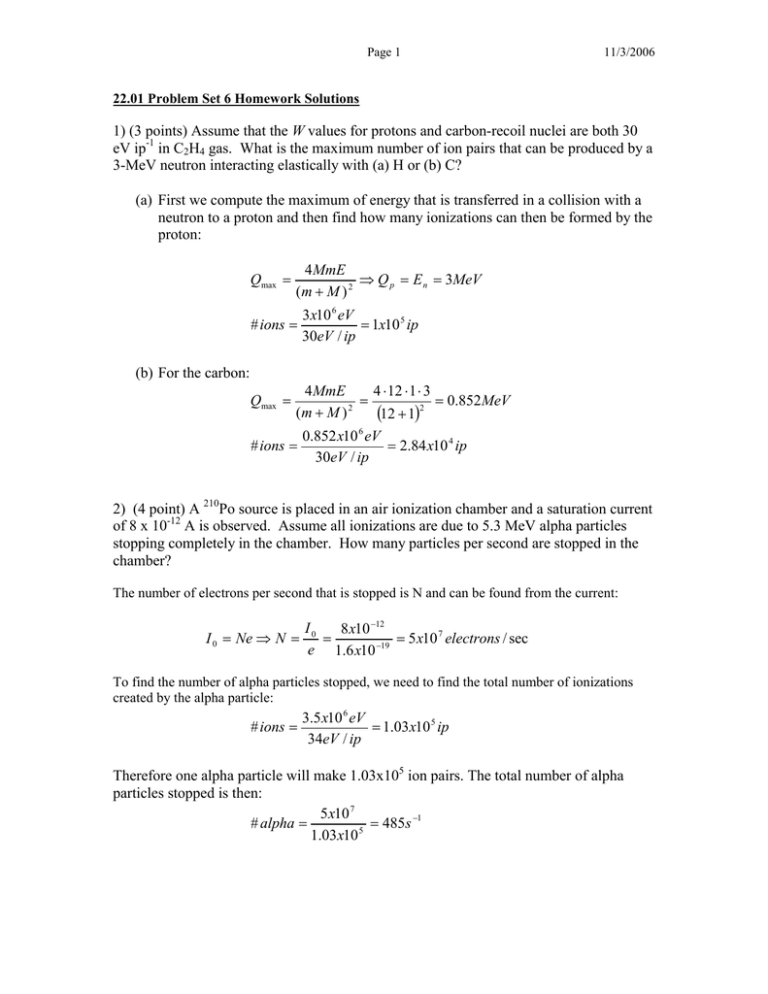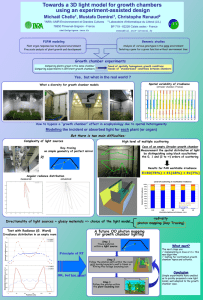Nuclear Engineering Homework Solutions - Problem Set 6
advertisement

Page 1 11/3/2006 22.01 Problem Set 6 Homework Solutions 1) (3 points) Assume that the W values for protons and carbon-recoil nuclei are both 30 eV ip-1 in C2H4 gas. What is the maximum number of ion pairs that can be produced by a 3-MeV neutron interacting elastically with (a) H or (b) C? (a) First we compute the maximum of energy that is transferred in a collision with a neutron to a proton and then find how many ionizations can then be formed by the proton: Qmax = 4MmE ⇒ Q p = E n = 3MeV (m + M ) 2 #ions = (b) For the carbon: Qmax = 3x10 6 eV = 1x10 5 ip 30eV / ip 4MmE 4 ⋅12 ⋅1⋅ 3 = 0.852MeV = 2 (m + M ) (12 + 1)2 #ions = 0.852x10 6 eV = 2.84x10 4 ip 30eV / ip 2) (4 point) A 210Po source is placed in an air ionization chamber and a saturation current of 8 x 10-12 A is observed. Assume all ionizations are due to 5.3 MeV alpha particles stopping completely in the chamber. How many particles per second are stopped in the chamber? The number of electrons per second that is stopped is N and can be found from the current: I0 8x10 −12 = = 5x10 7 electrons / sec I 0 = Ne ⇒ N = −19 e 1.6x10 To find the number of alpha particles stopped, we need to find the total number of ionizations created by the alpha particle: #ions = 3.5x10 6 eV = 1.03x10 5 ip 34eV / ip Therefore one alpha particle will make 1.03x105 ion pairs. The total number of alpha particles stopped is then: 5x10 7 # alpha = = 485s −1 5 1.03x10 Page 2 11/3/2006 3) (4 points) A saturation current of 2.70 x 10-14 A is measured with a parallel-plate ionization chamber in a radiation field. The chamber contains air (W = 34 eV ip-1) at 20°C and 752 torr. (a) What is the rate of the energy absorption in the chamber? Using equation 10.3: • Eabs = I oW (2.7x10 −14 ) x34eV = = 5.74x10 6 eV ⋅ s −1 −19 e 1.6x10 (b) If the chamber has a sensitive volume of 750 cm3, what is the dose rate in the air in J kg-1 s-1 (= Gy s-1)? Density of air is approximately 1.2x10-3 g/cm3. Dose is given by energy per unit mass. Calculating for dose rate: • D= 5.74x10 6 eV 1.6x10 −19 J 1 cm 3 1000g ⋅ ⋅ ⋅ ⋅ = 1.02x10 −9 Gy / s −3 3 s 1eV 750cm 1.2x10 g 1kg 4) (2 points) A 1.27-MeV photon loses 540 keV and 210 keV in successive Compton scattering events in the sensitive volume of a Ge detector before escaping. (a) Estimate the total number of secondary electrons produced by the events. The total number of secondary electrons produced is: #ions = 540x10 3 eV 210x10 3 eV + = 2.21x10 4 ip 34eV / ip 34eV / ip (b) Would the device register the passage of the photon as a single event or as two events? The device will register the passage of the photon as a single event. 5) (4 points) A 1.17-MeV gamma ray is Compton scattered once at an angle of 48° in a scintillator and again at an angle of 112° before escaping. (a) What (average) pulse height is registered? First we calculate the energy of the first scattered electron: Page 3 T = hν 1 − cosθ mc 2 hν + 1 − cosθ = 1.17 ⋅ 11/3/2006 1 − cos(48) = 0.504MeV .511 + 1 − cos(48) 1.17 Therefore the energy of the scattered photon was 0.665 MeV. Now calculating the energy of the second scattered electron: T = hν 1 − cosθ mc 2 hν + 1 − cosθ = 0.665 ⋅ 1 − cos(112) = 0.427MeV .511 + 1 − cos(112) 0.665 Therefore the average pulse height that is registered is the total energy of the two Compton scattered electrons which is 0.931 MeV. (b) If the photon were scattered once at 48° and then photoelectrically absorbed, what pulse height would be registered The pulse height would be the total energy of the photon, 1.17 MeV, because the Compton scattered electron will take 0.504 MeV and then the second interaction via the photoelectric effect will have the scattered gamma transfer its total remaining energy to the electron. 6) (4 points) A free-air ionization chamber operating under saturation conditions has a sensitive volume of 12 cm3. Exposed to a beam of X rays, it gives a reading of 5 x 10-6 mA. The temperature is 18° C and the pressure is 756 torr. What is the exposure rate? Exposure is defined as Gy/sec or energy per unit mass second. The total energy absorption in a gas chamber is: • Eabs = I oW (5x10 −6 x10 −3 )x34eV = = 1.06x1012 eV ⋅ s −1 −19 e 1.6x10 Density of air is approximately 1.2x10-3 g/cm3. Exposure rate is then: • X = 1.06x1012 eV 1.6x10 −19 J 1 cm 3 1000g ⋅ ⋅ ⋅ ⋅ = .0118Gy / s 3 −3 s 1eV 12cm 1.2x10 g 1kg 7) (2 points) When 38S decays, a single 1.88-MeV gamma photon is emitted in 95% of the transformations. Estimate the exposure rate at a distance of 3 m from a point source of 38S having an activity of 2.7 x 1012 Bq. Using equation 12.27 to calculate exposure: Page 4 • X = 0.5CE 0.5 ⋅1.88 ⋅ 2.7x1012 = 2 10 r2 3 ⋅ .3.7x10 11/3/2006 R ⋅ 0.95 = 7.24 hr 8) (4 points)A 100-cm3 sample of water is exposed to 1500 thermal neutrons cm-2 s-1. How many photons are emitted per second as a result of neutron capture by hydrogen? The cross section for the 1H(n,γ)2H reaction is 3.3 x 10-25 cm2. The number of photons emitted per second is calculated by: I = ϕ Nσ Solving for N: N = 100cm 3 ⋅ 1g 1mol 6.02x10 23 atoms 2H ⋅ ⋅ ⋅ = 6.7x10 24 atoms 3 mol 1H 2 O cm 18g Solving for the number of photons per second: I = 1500 ⋅ 3.3x10 −25 ⋅ 6.7x10 24 = 3.31x10 3 s −1 9) (3 points) Define energy straggling. Does energy straggling cause range straggling? The number of collisions and ionizations that occur along the path of a charged particle and the energy transferred in each collision is statistical in nature. Hence there will be a distribution of energies at a given transversed depth. This is known as energy straggling. Similarly there will be a distribution of path lengths until the particle stops, and this is known as range straggling. Energy straggling causes range straggling.




